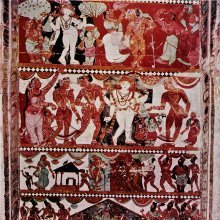Shivapurana, Śivapurāṇa, Shiva-purana: 10 definitions
Introduction:
Shivapurana means something in Hinduism, Sanskrit. If you want to know the exact meaning, history, etymology or English translation of this term then check out the descriptions on this page. Add your comment or reference to a book if you want to contribute to this summary article.
The Sanskrit term Śivapurāṇa can be transliterated into English as Sivapurana or Shivapurana, using the IAST transliteration scheme (?).
Images (photo gallery)
In Hinduism
Purana and Itihasa (epic history)
Source: archive.org: Shiva Purana - English TranslationŚivapurāṇa (शिवपुराण) according to the Śivapurāṇa-māhātmya 1.30-34.—“merely by listening to Śivapurāṇa (if such good results) what am I to say about the result when Śiva abides in the heart?. This work consists of twenty-four thousand verses divided into seven saṃhitās (compendiums). The three kinds of Devotion [(1) by meditation, (2) recital of prayer and (3) acts of worship and service] are fully explained in it. It must be listened to with great respect”.
There are seven saṃhitās defined for the Śivapurāṇa:
- Vidyeśvara-saṃhitā,
- Rudra-saṃhitā,
- Śatarudra-saṃhitā,
- Koṭirudra-saṃhitā,
- Umā-saṃhitā,
- Kailāsa-saṃhitā,
- Vāyavīya-saṃhitā.
Accordingly, “this divine Purāṇa of seven saṃhitās and called after Śiva stands on an equal footing with Brahman (i.e. Vedic Texts) and accords an achievement that is superior to everything else. He who reads the entire Śivapurāṇa without omitting any of the seven saṃhitās can be called a Jīvanmukta (a living liberated soul)”.
Accordin to the Śivapurāṇa 1.2, originally the Śivapurāṇa was of very enormous size consisting of twelve sacred saṃhitās:—
- Vidyeśvara-saṃhitā,
- Rudra-saṃhitā,
- Vaināyaka-saṃhitā,
- Aumika-saṃhitā,
- Mātṛ-saṃhitā,
- Rudraikādaśa-saṃhitā,
- Kailāsa-saṃhitā,
- Śatarudraka-saṃhitā,
- Sahasrakoṭirudra-saṃhitā,
- Koṭirudra-saṃhitā,
- Vāyavīya-saṃhitā,
- Dharmasaṃjña-saṃhitā.
“The first Saṃhitā of Vidyeśvara, consisted of ten thousand verses. The Raudra, Vaināyaka, Aumika and Mātṛ-saṃhitās consisted of eight thousand verses each. O Brahmins, the Rudraikādasa-saṃhitā consisted of thirteen thousand verses; the Kailāsa-saṃhitā of six thousand verses and the Śatarudra of three thousand verses. The Koṭirudra-saṃhitā consisted of nine thousand verses; the Sahasrakoṭi-rudra-saṃhitā of eleven thousand verses. The Vāyavīya-saṃhitā consisted of 4000 verses and the Dharma-saṃhitā of twelve thousand verses. Thus the whole Śivapurāṇa contained a hundred thousand verses”.
Source: Cologne Digital Sanskrit Dictionaries: The Purana IndexŚivapurāṇa (शिवपुराण).—One among the eighteen Purāṇas: comprises 24000 ślokas. sec. Śiva.*
- * Bhāgavata-purāṇa XII. 7. 23; 13. 4.
Śivapurāṇa (शिवपुराण) refers to one of the eighteen Major Puranas according to the Bhāgavatapurāṇa and other traditional lists of Puranic literature: a category of ancient Sanskrit texts which gives a huge contribution in the development of Indian literature.—The lists of eighteen Mahāpurāṇas (e.g., śivapurāṇa) and eighteen Upapurāṇas are not same everywhere, as some names are dropped in some references whereas some are included in others. It can be noticed that, except the Vāyuapurāṇa and the Śivapurāṇa, the names of the Mahāpurāṇas are similar in almost all the Purāṇas.

The Purana (पुराण, purāṇas) refers to Sanskrit literature preserving ancient India’s vast cultural history, including historical legends, religious ceremonies, various arts and sciences. The eighteen mahapuranas total over 400,000 shlokas (metrical couplets) and date to at least several centuries BCE.
Languages of India and abroad
Sanskrit dictionary
Source: DDSA: The practical Sanskrit-English dictionaryŚivapurāṇa (शिवपुराण).—Name of one of the eighteen Purāṇas.
Śivapurāṇa is a Sanskrit compound consisting of the terms śiva and purāṇa (पुराण).
Source: Cologne Digital Sanskrit Dictionaries: Cappeller Sanskrit-English DictionaryŚivapurāṇa (शिवपुराण).—[neuter] T. of a Purāṇa.
Source: Cologne Digital Sanskrit Dictionaries: Aufrecht Catalogus Catalogorum1) Śivapurāṇa (शिवपुराण) as mentioned in Aufrecht’s Catalogus Catalogorum:—It consists of twelf Saṃhitāḥ, namely Vighneśa, Rudra, Vināyaka, Bhauma, Mātṛkā, Rudraikadaśa, Kailāsa, Śatarudra, Koṭirudra, Sahasrakoṭirudra, Vāyavīya, Dharmasaṃhitā. These are hardly ever found together.
—Io. 43. 835. Oxf. 63^a. Paris. (B 14). L. 123. Khn. 32. K. 32. B. 2, 32. 34. Ben. 46. Bik. 210. Tu7b. 15. Kāṭm. 1. NW. 496. Np. V, 10. Burnell. 203^b. Bh. 16. P. 9. Poona. 194. 341. 345. 651. Ii, 77. 78. H. 48. Oppert. 4258. 6534. 7019. 8297. Sūcīpattra. 69. Mentioned in Kūrmapurāṇa Oxf. 8^a, in Varāhapurāṇa Oxf. 59^a, in Revāmāhātmya Oxf. 65^a. Śivapurāṇe Avimuktamāhātmya. Oudh. V, 2.
—Ādicidambaramāhātmya. [Mackenzie Collection] 63.
—Ekādaśarudrasaṃhitā. Burnell. 203^b.
—Kailāsasaṃhitā. Ben. 52. Oudh. V, 2. Xv, 22. Np. Viii, 20. Ix, 20. X, 22.
—Koṭirudrasaṃhitā. Oudh. Xv, 20.
—Jyeṣṭhalalitāvrata. W. p. 341.
—Tṛtīyāvratakathā. P. 9.
—Badarīvanamāhātmya. [Mackenzie Collection] 82.
—Bilvavanamāhātmya. [Mackenzie Collection] 84.
—Bhaumasaṃhitā. Oudh. Xv, 20.
—Mayūrapuramāhātmya. [Mackenzie Collection] 79.
—Vāyavīyasaṃhitā. Ben. 52. Oudh. V, 4. Xv, 22. Burnell. 203^b.
—Vighneśvarasaṃhitā. Ben. 52. Oudh. V, 4. Xiv, 24.
—Viśveśvarasaṃhitā. Ben. 52. Np. Ix, 20. X, 22.
—Vyāsapūjanasaṃhitā. Oudh. V, 4.
—Śatarudrasaṃhitā. Oudh. Xv, 20.
—Śivarātrimāhātmye Mṛgīsaṃvāda. W. p. 341.
—Sādhyasādhanakhaṇḍa. Sūcīpattra. 69.
—Hemasabhānāthamāhātmya. Burnell. 203^b.
2) Śivapurāṇa (शिवपुराण):—from the Brahmottarakhaṇḍa of the Skandapurāṇa. Cop. 99 (Jñānakhaṇḍa). Io. 44. Oxf. 73^a. 75^a. Bik. 209. Rādh. 41 (laghu and bṛhat). Peters. 1, 120. Sanatkumārasaṃhitā. Ben. 52. Laghuśivapurāṇa, an abridgment. Oxf. 75^a.
3) Śivapurāṇa (शिवपुराण):—Gov. Or. Libr. Madras 95. Stein 214 (inc.). 215 (inc.). Śivapurāṇe Kailāsasaṃhitā. Stein 215 (chapters 31-42).
—Vāyavīyasaṃhitā. Stein 215.
—Śivagītā. Stein 215.
—Sanatkumārasaṃhitā. Stein 215.
—Sādhyasādhanakhaṇḍa. Stein 215.
—Sumanaḥśodhana. Fl. 430.
4) Śivapurāṇa (शिवपुराण):—from the Brahmottarakhaṇḍa of the Skandapurāṇa. Laghuśivapurāṇa in 19 chapters. Oudh. Xx, 34.
5) Śivapurāṇa (शिवपुराण):—Ulwar 879 (Vāyavīyasaṃhitā, Vighneśvarasaṃhitā, Īśvarasaṃhitā, Kailāsasaṃhitā, Koṭirudrasaṃhitā).
—from the Brahmottarakhaṇḍa of the Skandapurāṇa. Ulwar 880.
6) Śivapurāṇa (शिवपुराण):—As p. 201 (4 Mss. one inc. The fourth contains the Kailāsasaṃhitā). Bc 296. Il (Jñānasaṃhitā in 75 Adhyāyāḥ, as in Catal. Oxon. No. 113). Io. 43. 835. 1876. 2659 a. 2815 (these five contain the Jñānasaṃhitā). 1081. 1101. Cs 4, 297 (these 3 Vāyavīyasaṃhitā). Hpr. 2, 237 (Sanatkumārasaṃhitā). Io. 2559 b. No. 3616 (Dharmasaṃhitā). Cs 4, 206. 207 (both inc.). These 2 hither? Śivapurāṇa laghu. Peters. 6, 164. Śivapurāṇa bṛhat. Peters. 6, 165. Śivapurāṇe Kedārakalpa. Il. L.. 364 (inc.). Peters. 5, 172.
—Cyutapuramāhātmya. Hz. 1076. Śivapurāṇe Japyeśvaramāhātmya. Hz. 1167.
—Pārvatyaparādhavrata. L.. 314.
—Ekādaśarudrasaṃhitāyām Puṇḍarīkapuramāhātmya. Hz. 1170.
—Pradoṣaśivapūjā. Cs 2, 357.
—Vaidyanāthamāhātmya. Hz. 1164.
Śivapurāṇa (शिवपुराण):—[=śiva-purāṇa] [from śiva] n. Name of one of the 18 Puraṇas (devoted to the praise of Śiva, and consisting of 12 Saṃhitās, viz. Vighneśa, Rudra, Vināyaka, Bhauma, Mātṛkā, Rudraikadaśa, Kailāsa, Śata-rudra, Koṭi-rudra, Sahasra-koṭi-rudra, Vāyavīya, and Dharma-saṃhitā)
[Sanskrit to German]
Sanskrit, also spelled संस्कृतम् (saṃskṛtam), is an ancient language of India commonly seen as the grandmother of the Indo-European language family (even English!). Closely allied with Prakrit and Pali, Sanskrit is more exhaustive in both grammar and terms and has the most extensive collection of literature in the world, greatly surpassing its sister-languages Greek and Latin.
Kannada-English dictionary
Source: Alar: Kannada-English corpusŚivapurāṇa (ಶಿವಪುರಾಣ):—[noun] one of the eighteen major Purāṇas.
Kannada is a Dravidian language (as opposed to the Indo-European language family) mainly spoken in the southwestern region of India.
Nepali dictionary
Source: unoes: Nepali-English DictionaryŚivapurāṇa (शिवपुराण):—n. name of one of the eighteen puranas (पुराण [purāṇa] );
Nepali is the primary language of the Nepalese people counting almost 20 million native speakers. The country of Nepal is situated in the Himalaya mountain range to the north of India.
See also (Relevant definitions)
Partial matches: Shiva, Purana, Puraana, Civa.
Starts with: Shivapuranatamasatvakhandana.
Ends with: Laghushivapurana.
Full-text (+10375): Shatarudrasamhita, Candishapurana, Darukavana, Shivapuranatamasatvakhandana, Ghushmesha, Korali, Tryakshaka, Hathatkara, Akhatishvaratirtha, Namavidhi, Abimukta, Kalpaga, Kumbheshvaratirtha, Kuberatirtha, Kapitirtha, Kauberatirtha, Dhatakitirtha, Nagatirtha, Kandarpadahana, Jamburudra.
Relevant text
Search found 39 books and stories containing Shivapurana, Śivapurāṇa, Shiva-purana, Sivapurana, Śiva-purāṇa, Siva-purana; (plurals include: Shivapuranas, Śivapurāṇas, puranas, Sivapuranas, purāṇas). You can also click to the full overview containing English textual excerpts. Below are direct links for the most relevant articles:
The Shiva Purana (by J. L. Shastri)
Chapter 2 - Answers Clarifying the Doubts of the Sages < [Section 1 - Vidyeśvara-saṃhitā]
Chapter 1 - Greatness of Śivapurāṇa < [Śivapurāṇa-māhātmya]
The backdrop of the Srikanthacarita and the Mankhakosa (by Dhrubajit Sarma)
Part 2 - Source of the poem [Śrīkaṇṭhacarita] < [Chapter II - The Śrīkaṇṭhacarita]
Part 6 - Innovations and deviations < [Chapter II - The Śrīkaṇṭhacarita]
Rudra-Shiva concept (Study) (by Maumita Bhattacharjee)
5. Epithets of Rudra-Śiva tracked in the Upaniṣadic literature < [Chapter 6b - Epithets (References)]
6. Common epithets of Rudra and Śiva < [Chapter 6b - Epithets (References)]
2. Physical appearance of Śiva < [Chapter 5 - Rudra-Śiva in the Purāṇic Literature]
Temples of Munnur (Historical Study) (by R. Muthuraman)
The Vishnu Purana (by Horace Hayman Wilson)
The Upa-purāṇas < [Preface]
4. The Vāyavīya Purāṇa < [Preface]
Classification of the Purāṇas < [Preface]
The Markandeya Purana (Study) (by Chandamita Bhattacharya)
Related products




